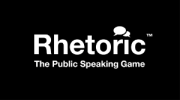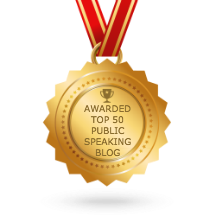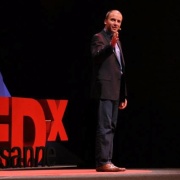Many people think of a speech as something that is linear: introduction; development of the main points; and conclusion. As in the image below:
And, true enough, when I deliver a speech, I begin by introducing the subject; I then proceed to develop the main points in support of my objective; and I bring the whole thing to a conclusion. However, although I follow the same broad structure as in the image above, the basic geometry of my speeches is different.
I believe that a speech should be circular. Not in the sense that you keep going over the same point again and again. Rather, I mean that the conclusion should somehow bring the audience back to the introduction.
Think about some of the great stories you’ve heard or read about or seen in the theatre: fairy tales such as Jack and the Beanstalk; novels such as The Hobbit; movies such as The Lord of the Rings. They are all circular because they end where they began.
Of course, that does not mean that everything is the same. (If it were, then there wouldn’t be much of a story.) The protagonist is not the same as he was at the outset. After completing his quest or adventure, the protagonist has usually undergone a personal transformation. However, he brings that new wisdom and experience — and, in Jack’s case, a goose that lays golden eggs — back home.
Our speeches should do the same. They should change our audiences in some way, but bring them back to the start with that new knowledge or information.
So how do we go about it?
Well, it all depends on how you begin. My friend and public speaking colleague, Florian Mueck, stresses the importance of our introductions in his book, The Seven Minute Star:
When you speak in public, you have about 30 seconds, more or less, to create that tension between yourself and your listeners, to gain and hold their attention. Your very first sentence is the most crucial rhetorical tool you’ll ever have — it’s like the cat’s paw, because you must use it to grab your audience’s attention. …
An opening sentence must be catchy, a grabber — powerful.
Once you have chosen an effective introduction for your speech, you already have the makings of an equally effective conclusion. Here are some examples to consider:
- You could open with a rhetorical question and conclude by returning to that question. Offer an answer or encourage the audience members to reflect on the question and come up with their own answers. For example, if you open with What would you do if you knew you only had three months to live?, you could conclude by asking the audience the same question and encouraging them to think about what is most important in their lives.
- You could open with a powerful quotation and conclude with another powerful (and relevant) quotation by the same person. Or you could conclude by offering your reflections on that opening quotation in light of your speech. Or you could give another quotation by someone else and compare it with the first one.
- You could open with the beginning of a personal story and then transition away from it (before its conclusion) into the main body of your speech. For the conclusion of your speech, you could return to the personal story from where you left off, tell the audience how it turned out and weave its conclusion together with that of your speech.
- You could open by setting out a challenge that the audience is facing — environmental degradation of the nation’s rivers; declining sales for the company; the proposed construction of a nuclear waste dump near the community. You could then conclude by summarizing the steps that the audience can take to meet and overcome the challenge.
There are many different ways in which to do it and I encourage you to think of others.
Making your speeches circular will add polish to them. By returning to your introduction, you will signal to the audience that you are coming to a conclusion. You will reinforce the main theme of your talk. You will crystalize your message in your audience’s mind as if you were tying the two ends of your speech together and sealing the message inside.
Thus, I invite you to think about the basic geometry of your next speech in this way:










Pingback: Analysis of a Speech by Andrew Solomon - Manner of SpeakingManner of Speaking
Pingback: Seabiscuit and Public Speaking - Manner of SpeakingManner of Speaking
Pingback: A lesson from the skyline of Chicago | Manner of Speaking
Pingback: Analysis of a Speech by Andrew Solomon | Manner of Speaking
Thank you a million John for sharing. What an amazing article. I wish I read this long ago. 🙂
LikeLike
Thanks, Mark. Glad that you found the post useful.
John
LikeLike
John, I love this concept! Thanks for sharing great ideas and examples in this post.
Here’s my own contribution, which builds on what you’ve presented above:
LikeLike
Thanks Craig. And thanks for furthering the discussion and building upon it in your post. Great stuff!
John
LikeLike
Pingback: Picture your talk as a shape… Now, what shape do you see? | Remote Possibilities
Pingback: Lutfi Torla.com – Tell a Story in Circles
Pingback: Tell a Story in Circles | Lutfi Torla.com
Pingback: Lessons from a Stunning Three-Minute Stop Motion Film | Manner of Speaking
Pingback: Analysis of a Speech by Alberto Cairo | Manner of Speaking
Pingback: Perfect Public Speaking is an Asymptote | Manner of Speaking
John, your pearls of wisdom are priceless as I prepare and deliver my Teacher Training workshops to middle school teachers. I incorporate TM speaking techniques into my delivery and encourage teachers to do the same when conducting a class. These techniques translate beautifully into the classroom to engage students. Thanks so much for your guidance … you’re helping us CHANGE THE WORLD!
PS – Spoke to Laura the other day, looking forward to arranging to have you as a guest in our Milan TM club next year. Cheers my friend!
LikeLike
Thank you very much for the comment and kind words, Andy. I have no doubt that you too are doing your fair share to change the world. (After all, why bother to give a speech if not to change the world, even a small part of it?)
Very much looking forward to visiting your club in Milan and exchanging ideas and experiences.
Ci vediamo!
John
LikeLike